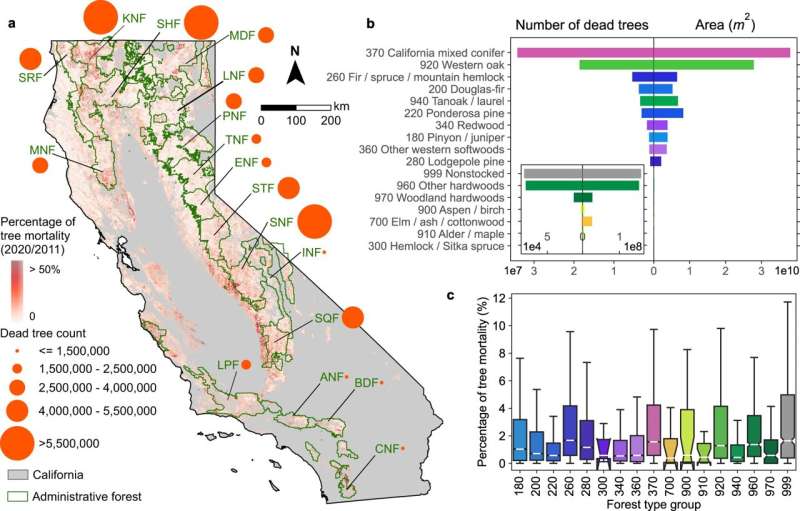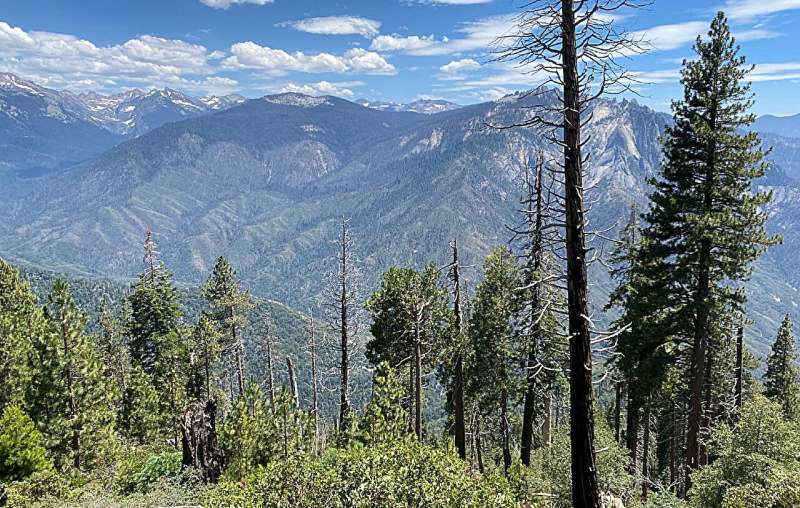This article has been reviewed according to Science X's editorial process and policies. Editors have highlighted the following attributes while ensuring the content's credibility:
fact-checked
peer-reviewed publication
trusted source
proofread
AI method reveals millions of dead trees hidden among the living before California's historic 2020 wildfires

University of Copenhagen scientists may have found a new explanation for the California wildfires of 2020. Applying AI to detailed aerial photos, they created a unique dataset detailing mortality down to single trees for all of California State. This revealed individual and clustered tree death spread out among the living on a large scale. The new AI-model will increase understanding of tree mortality and give us a chance to prevent droughts, beetles and flames from destroying the world's forests.
For better or worse, climate change has thrust forests into the global limelight. Initiatives to plant trees and increase forest area have sprung up worldwide because trees can extract and store atmospheric CO2. At the same time, massive and more frequent wildfires have raged and forced hundreds of thousands of people from their homes.
California has been one of the places hit hardest by droughts and wildfires, and saw 4% of its landmass go up in smoke in 2020. Now, scientists at the University of Copenhagen present a new picture of the health of Californian forests, revealing a new account of dead trees in the region, and possibly a new underlying explanation for the extensive fires in a study published in Nature Communications.
Leveraging an optimized AI model applied to aerial photos with sub-meter resolution, the researchers were able to extensively map tree health across the entire Californian State (over 90 million trees), detailing the spread of dead trees with a precision never achieved before. Importantly, the feat revealed an undercount of dead trees all sharing a special characteristic.
"Our data show that a vast amount of these trees are isolated or located in small clusters of only a few trees, which has allowed them to hide scattered amidst healthy, living trees from coarse-resolution satellite images. This is new knowledge," says Stéphanie Horion from the University of Copenhagen's Department of Geosciences and Natural Resource Management.
According to the researcher, fire spread during wildfires is strongly related to the uneven distribution of fuel in both density and flammability.
"This makes it reasonable to speculate that such scattered enclaves of dead dry trees could have acted as kindling between living trees, affecting the intensity and spreading of the wildfires. This new knowledge is interesting both as a possible part of the explanation for California's violent wildfires, but also very much for our attempts at understanding the phenomenon of tree death more generally," says Horion.
Fire isn't the biggest tree killer
Understanding fire was not the intention of the study. Rather than studying forest fires in and of themselves, the researchers sought to understand the global phenomenon of massive tree death, whereby large areas of forest suddenly die out. The phenomenon has become increasingly frequent and is driven by climate change.

Due to the impressive and threatening nature of wildfires, in the public eye they are often erroneously viewed as the singular greatest cause of tree death. The California case study shows this is not the case. In fact, it turns out to be the other way around.
"The new data shows that drought and subsequent insect attacks are the biggest killers in forests. Fire can follow as an indirect consequence. For a wildfire to erupt, three basic elements are necessary: hot, dry weather and climatic conditions that climate change has increased the frequency of, an ignition source—such as a lightning strike or careless human—and finally, an abundance of combustible materials. Drought weakens 'the immune systems' of trees, which increases the risk of tree mortality in the wake of bark beetle attacks. And dead trees burn well," explains Horion.
She points to the Harz Forest in Germany as an example of massive forest death, where drought and then bark beetles killed huge swaths well before any wildfire.
"Ironically, many locals were delighted when bark beetles were first discovered there, as it was considered as a sign of forest health and biodiversity. Since then, it has been shown that these beetles spread like an epidemic during times of drought, and that a third of the trees in the Harz Forest have now died as a result. We need to learn from this if tree planting is to play an important role as a climate solution," says the researcher.
She underscores that the new AI model could become a vital tool in the future, as the effective mapping of tree deaths can provide researchers and public agencies with an early warning system that makes it possible to intervene in time.
AI monitoring of tree death has global potential and importance
To develop the new method, first author of the study, Yan Cheng trained an AI-model to examine detailed aerial photos and recognize signs of tree death. To achieve this, Yan, who is a Ph.D. student on the DRYTIP project that investigates drought-induced ecosystem tipping points, used more than 20,000 computer-friendly polygons to define areas with specific characteristics.
Polygons are a way of dividing an area into clearly defined parts suitable for AI learning, and were used to train the AI to recognize trees in varying conditions and distinguish dead from alive (i.e. varying landscapes and varying stages of dying). Put very simply, the approach makes it possible to distinguish between living forests, dead forests and forests with a mixture of dead and living trees.
The result was significant in the subsequent case study to test the model, which consisted of a large number of high-quality aerial photos of California forests.
"The model performs way beyond expectations. Of the 90 million dead trees that our artificial intelligence identified, about 60% would have remained unseen using the current state-of-the-art method of mapping forest disturbances (i.e. damages to forest health)," Yan Cheng explains.
The problem of climate-induced tree death, however, is far from local. Fortunately, the method has also proved useful in other parts of the world, and the researchers are now conducting similar studies in more places around the world.
"Since California, we've tested it in other places. And, even without calibrating the model for other forest types, it has provided surprisingly accurate results. Once calibrated for local conditions, with regards to local tree types and terrain, it will be even more effective," says Cheng.
The researchers hope their algorithm can become an important global tool. In support of this aim, both their results and the code are freely available to researchers and public agencies.
More information: Yan Cheng et al, Scattered tree death contributes to substantial forest loss in California, Nature Communications (2024). DOI: 10.1038/s41467-024-44991-z
Journal information: Nature Communications
Provided by University of Copenhagen


















